 Due to certain circumstances, women's wardrobes very often contain things that do not fit the figure very well. And there are a great many reasons for this, from banal fluctuations in body weight to purchases on sales during seasonal discounts.
Due to certain circumstances, women's wardrobes very often contain things that do not fit the figure very well. And there are a great many reasons for this, from banal fluctuations in body weight to purchases on sales during seasonal discounts.
Of course, if your favorite skirt has become too small, then the problem takes on the scale of a planetary catastrophe. But if, on the contrary, it turns out to be too big, then it is enough to just sew the skirt up, laying a few machine lines in new places.
We'll tell you how to do this work yourself.
How to sew a skirt at the waist
There are many ways to sew a skirt. Some of them require basic design knowledge, while others simply need to know how to use a sewing machine. However, before you give preference to one of them, you should decide on several important points.
- How many sizes does the product need to be reduced by?
- In what places does modification need to be done?
- What features are typical for the cut of an existing skirt?
To do this, just put on a skirt and look carefully in the mirror.
If you need to sew in a waist size of 1-size, then the whole process will not take much time and will turn into a pleasant pastime.
Reworking the product
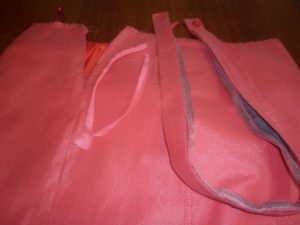
In cases where the skirt fits perfectly on the hips and dangles in the belt, You can remove excess by increasing the depth of the darts. To do this you will need to work with the product.
Beginning of work
- Put on a skirt and carefully measure how many extra centimeters you need to remove
- Flog the belt or facing.
- Open up existing darts.
- Iron the product.
- Calculate the depth of new darts. In order not to delve into the nuances of design, It is enough to evenly distribute the existing surplus into 4 darts: 2 rear and 2 front.
Calculation of dart depth
If you need to sew in a skirt at the waist by 10 cm, then the calculation looks like this: 10 cm: 4 darts = 2.5 cm.
Important! Since the dart is an isosceles triangle, you should add 1.25 cm, the second half will be laid symmetrically.
This action, which at first glance seems absolutely uncomplicated, should be approached with the utmost care. After all even a slight distortion of a few millimeters will be clearly visible on the finished product.
Continued work
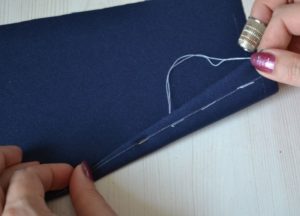
- Mark the darts using a well-sharpened tailor's chalk or fabric marker. note that lay new darts in the same place.
- Baste darts.
- Put on a skirt to make sure everything is done correctly. If minor defects are discovered during fitting, correct them.
- Sew machine stitches, not forgetting to make bartacks on each side.
Advice. To make the darts as neat as possible, the lines should be laid from the solution to the base.
- Iron darts towards the center. They must look at each other.
- Shorten the belt or facing by the same number of centimeters as you removed in the darts.
Note! The belt has an arched shape, repeating the line of the upper cut of the skirt. Therefore, excess should be removed symmetrically on both sides.
- Baste the details of the belt or facing, and then stitch on the sewing machine.
- Iron the seam.
- Baste the waistband/facing.
- Machine stitch.
- Press the seam well.
Reducing volume without tearing
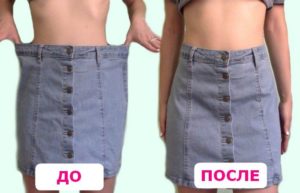
This method is an ideal solution when a skirt needs to be sewn up 1–1.5 sizes in the waistband. As in all other cases, work on altering a product begins with a fitting, during which it is determined exactly how much should be removed from the waist.
With this method, all that needs to be done is limited to two actions:
- draw a new seam line on the product;
- grind.
Important! Depending on the style, excess fabric is removed in one seam (if it is located in the center of the back) or in 2 seams (if they are located on the sides).
If the skirt has a belt, then you can lay the seams on top of it. The main thing is to combine the top and bottom lines so that there are no distortions that significantly spoil the appearance of the clothes. But if the style provides for facing, then it is much better, neater and more beautiful to do the work as follows.
- Trim the facing (without cutting).
- Fold it up so it looks like a continuation of the product.
- Iron.
- Draw a line for the new seam.
- Sweep, try on.
- Sew on a sewing machine.
- Cut off allowances (process if necessary).
- Iron again.
- Secure the facing.
How to sew a circle skirt at the waist
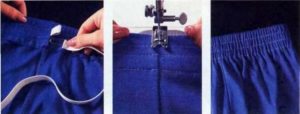
In cases where you need to reduce the waist of a circle/semi-circle skirt, this can also be done in two ways:
- without ripping;
- without ripping.
In the first case, you will not need to perform any sewing manipulations; just insert an elastic band into the belt.
But in the second, the following actions will be required.
- Undo the belt.
- Reduce it by N number of centimeters.
- Gather the top section of the skirt.
- Baste the belt.
- Machine stitch and iron.
The easiest way
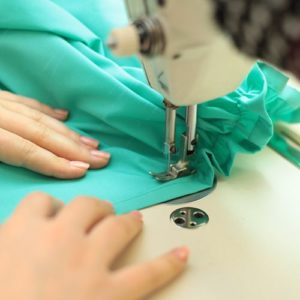
The simplest and easiest way to gather the top section of a skirt is as follows.
- Set the machine to the maximum stitch length.
- Sew along the top edge, 0.5–1 cm from the edge.
- Carefully tighten the threads. The assemblies form on their own; all that remains is to distribute them evenly throughout the cut.
Important! The thread needs to be pulled out exactly as many centimeters as you want to reduce the volume at the waist.
How to sew in the sides of a skirt
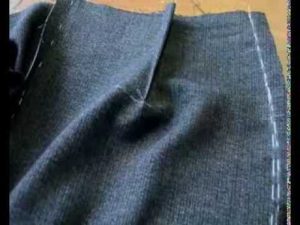
It is not always possible to sew a product to the desired size simply by increasing the depth of the darts or reducing it in the waistband. Sometimes adjustments have to be made along the entire length of the skirt. In this case, you can remove excess fabric from the sides.
Important! If you plan to reduce a skirt that has darts by 3-4 or more sizes, then in no case should you remove all the excess just by adjusting the allowances of the side seams.
It is better to transfer some of the excess to the darts so that they do not move significantly from the center to the sides. Otherwise, the altered item will not fit well and will look slightly ridiculous.
The work begins with fitting, during which they determine where the new seams will be placed. Of course, it’s good if at this stage of work you manage to find an assistant. But with some skill, you can cope on your own.
Completing of the work
- The excess is evenly distributed on 2 sides and pinned off with tailor's pins.
- Remove the skirt, turn it inside out and draw a dotted line at the chipped areas.
- Remove the pins.
- Check the symmetry of the drawn lines and adjust if necessary.
- Swept away.
- They try it on.
- If the village is ideal, then they grind it by car.
- Cut off the excess and process the seams.
- Ironing.
Useful tips for sewing a skirt

- In sewing, 90% of success depends on taking measurements correctly. Therefore, never rush and remember to use the golden rule “Measure twice, cut once.”
- Even if you are in a hurry, do not neglect preliminary fittings. All defects are much easier to correct at the basting stage, and not after strong machine stitches with bartacks have been laid.
- Wet heat treatment (WHT) is one of the pillars of a quality sewn product. Make it a rule to always iron your seams, this is the only way you will achieve the perfect appearance.
- Even if the iron has a steam function, it is still better to iron the seams through thin, undyed cotton fabric or gauze.


 1
1


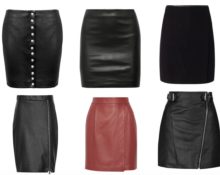
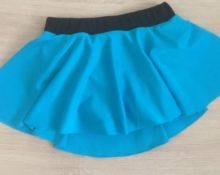
_1-220x175.jpg)

Good afternoon I'm not very literate when it comes to design, so I need help! I cut out a half-sun skirt, and it turned out that it was too big by a decent number of centimeters. Is it possible to reduce it from the sides without gathering at the waist? Thank you!